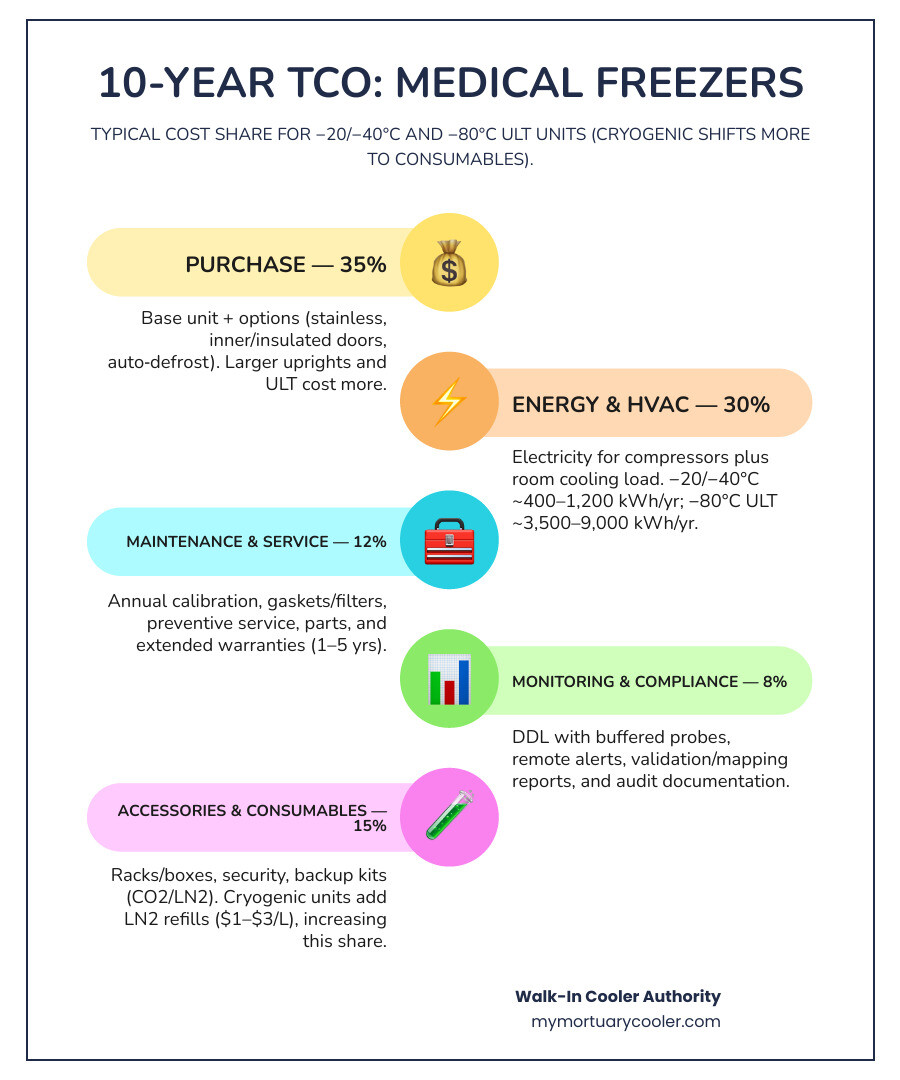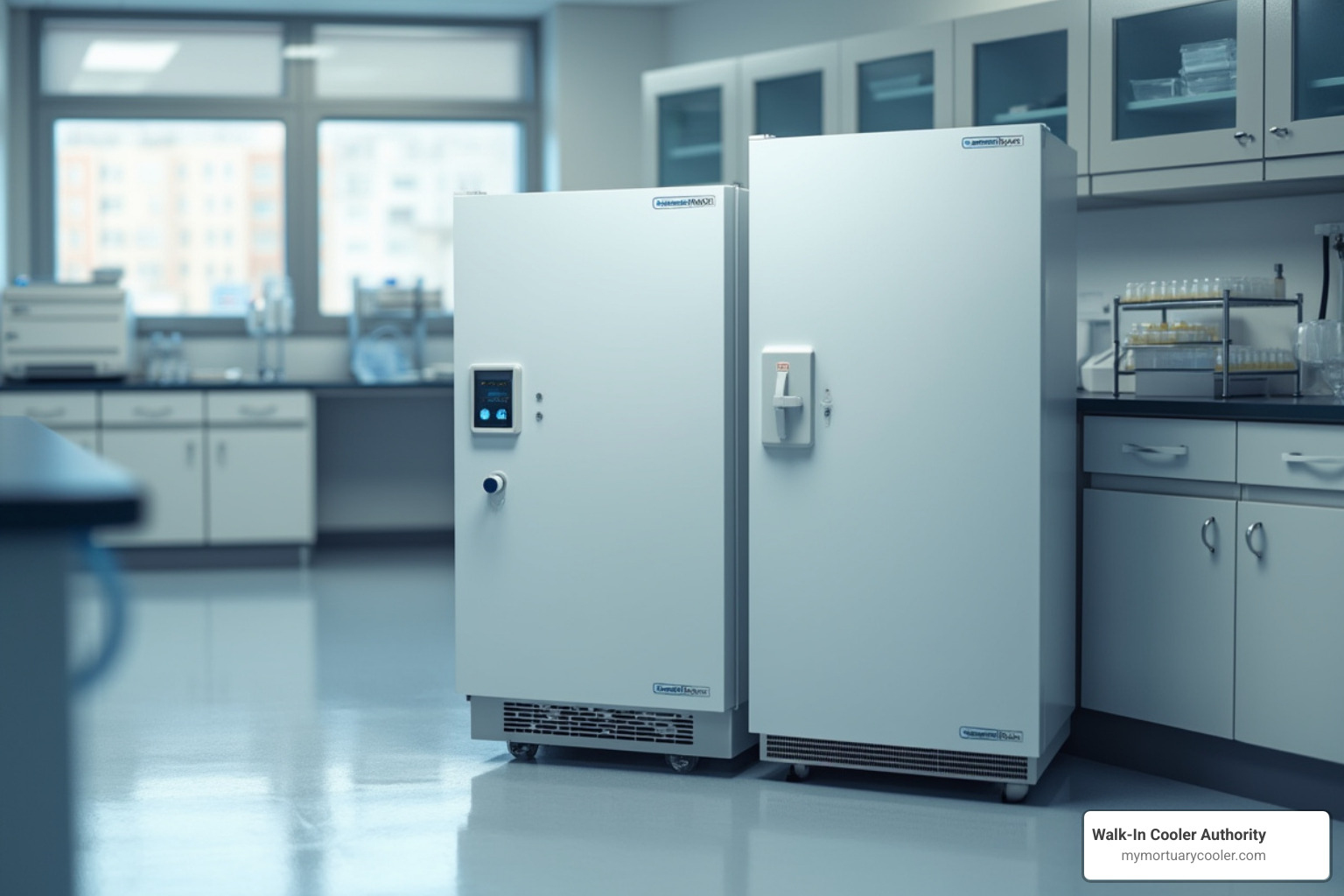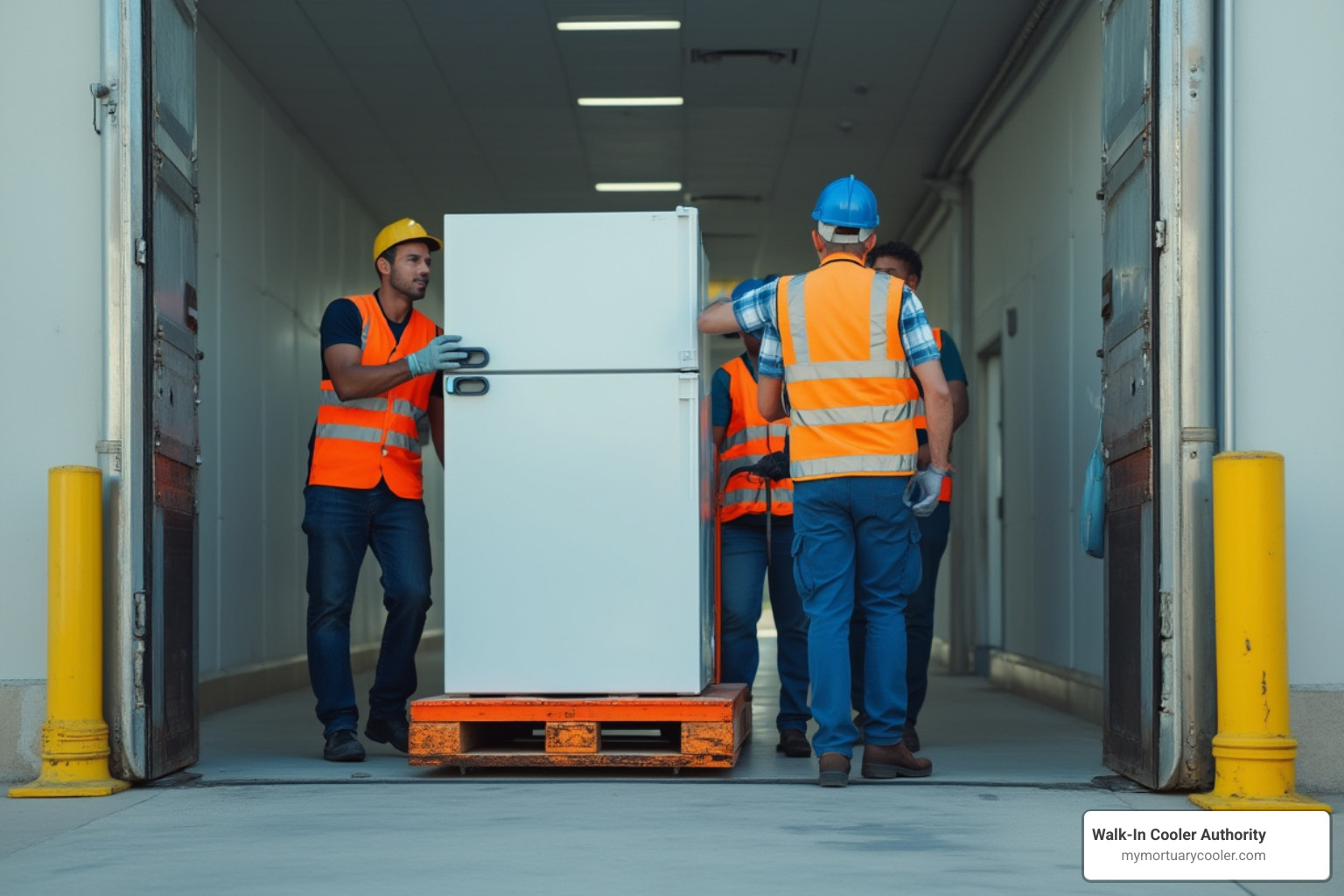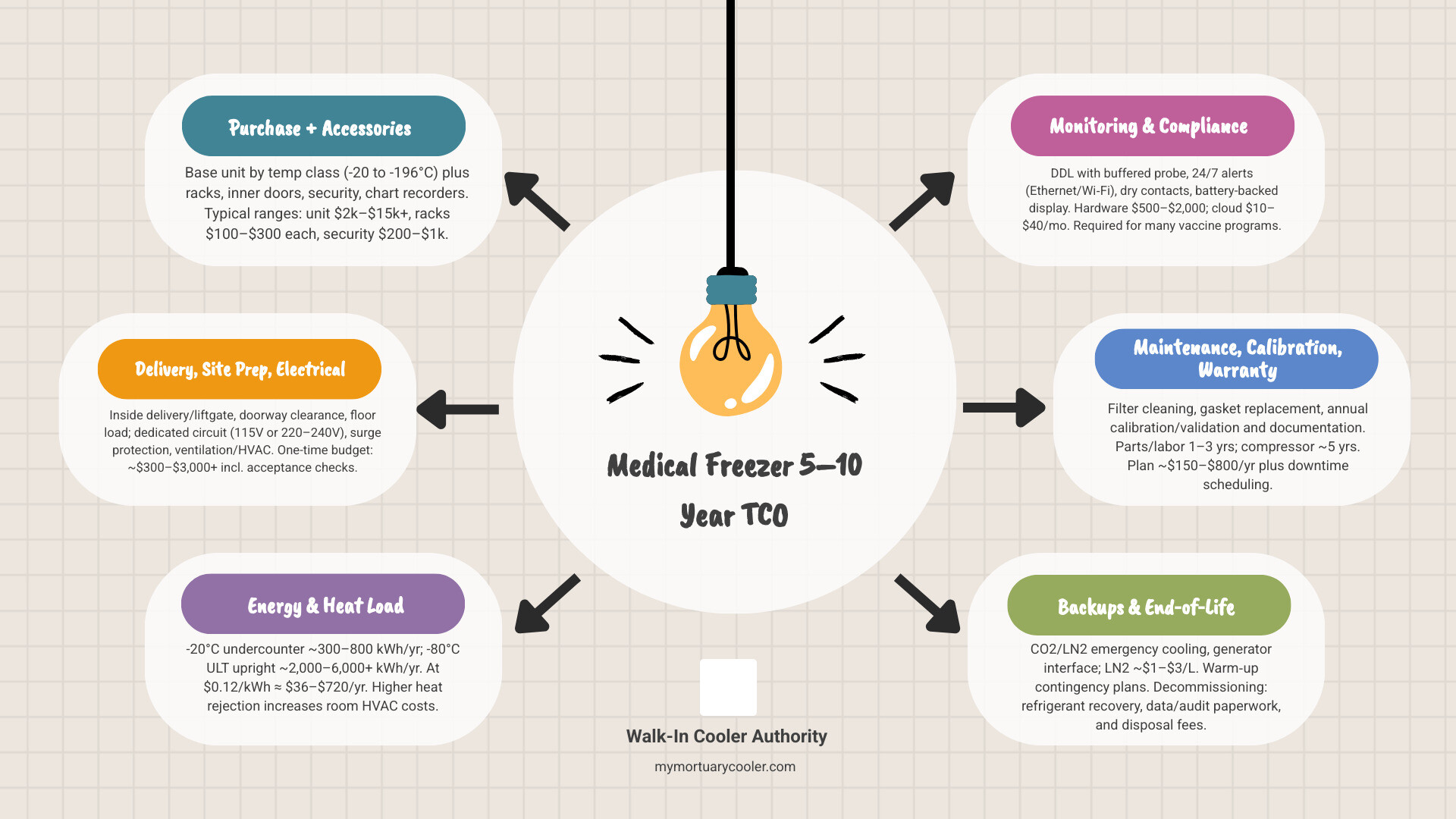Understanding Medical Freezer Price Points for Professional Cold Storage
Medical freezer price depends on temperature class, capacity, construction, and compliance. Use these quick references:
Quick Price Reference:
- Standard medical freezers (-20 C to -40 C): $3,000-$8,000
- Ultra-low temperature (ULT) freezers (-80 C): $1,915-$2,692 for chest models
- Cryogenic freezers (-150 C to -196 C): $3,000-$20,000
- Key add-ons: Monitoring systems (+$500-$2,000), stainless steel construction (+$2,000-$5,000), automatic defrost (+$1,000-$5,000)
Unlike household units, medical freezers deliver verified temperature uniformity, fast recovery after door openings, and continuous monitoring with alarms and audit trails. Those performance and compliance features drive cost.
Total cost of ownership matters more than sticker price. Options like stainless interiors, improved monitoring, and backup systems can bring a basic -80 C chest unit from under $2,700 to $10,000+. Over 5-10 years, energy, LN2 (for cryo), maintenance, validation, and data-logging subscriptions often exceed the initial purchase.

What qualifies a medical-grade freezer and why it matters
Medical-grade freezers are engineered for precision and proof. They hold tight temperature bands, recover quickly after openings, and document performance continuously.
Core differentiators:
- Microprocessor controls + quality sensors (thermocouples/RTDs) for accuracy
- Verified uniformity and stability via temperature mapping
- Fast recovery aided by heavy insulation, robust gaskets, inner doors/compartments, and fan-forced airflow
- Continuous data logging, alarms, access controls, and audit trails for compliance
These features increase medical freezer price, but they protect sample integrity and satisfy regulatory demands.
Medical-grade vs household vs commercial
- Household units are built for convenience, not precision or documentation.
- General commercial models are better than household, but typically lack medical-grade monitoring and validation.
- Medical-grade units include buffered probes, door-open alarms, password-protected setpoints, and service-friendly designs.
For vaccines, follow the CDC Vaccine Storage and Handling Resources.
Temperature classes and use cases
- -20 C: Vaccines, meds, reagents (best cost-performance balance)
- -30/-40 C: Sensitive biologics; many models are manual defrost for maximum stability
- -80 C ULT: DNA/RNA, tissues, long-term storage; dual-stage compressors
- -150 to -196 C cryogenic: LN2-based for cryopreservation; adds ongoing LN2 costs
Key specs that affect outcomes (and price): pull-down time, recovery after door openings, and warm-up hold time during power loss.
Performance specs that influence outcomes
- Uniformity: B11–5 C depending on design; tighter uniformity costs more but protects sensitive samples
- Stability: Consistent setpoint over time
- Recovery: Inner doors, compartments, and airflow reduce post-opening excursions
- Door-open behavior: Chest freezers retain cold better than uprights
- Defrost: Manual defrost = most stable; automatic/adaptive adds convenience but small temperature pulses
Match features to workflow: high-access labs benefit from inner doors and stronger airflow; long-term storage may prioritize manual defrost and maximum stability.
Medical freezer price: quick ranges and key drivers
Understanding medical freezer price means accounting for precision, documentation, and compliance—not just cold storage.
Temperature class is the biggest driver. A -20 C vaccine unit may be $3,000-$6,000; a -80 C ULT ranges from $1,915 for basic chest to $10,000+ for fully featured uprights. Cryogenic (-150 to -196 C) typically runs $3,000-$15,000, with premium builds up to $20,000.

Here's how the different temperature classes break down for typical applications:
| Temperature class | Typical uses | Common form factors | Typical capacities | Typical price range |
|---|---|---|---|---|
| -20 C | Vaccines, meds, reagents | Undercounter, upright, benchtop | 1–49 cu ft | $3,000–$6,000 (benchtop/undercounter); $5,000–$8,000 (upright) |
| -30/-40 C | Sensitive biologics, long-term reagents | Chest (often manual defrost), upright | 3–30+ cu ft | $4,000–$9,000 depending on size/features |
| -80 C ULT | DNA/RNA, tissues, some vaccines | Chest, upright, compact benchtop | 0.5–30+ cu ft | Chest examples: $1,915–$2,692 for listed -85 C models; uprights typically higher |
| -150 to -196 C cryogenic | Cells/tissues cryopreservation | Benchtop, chest, upright (LN2-based) | Canister-based; varies by canister | $3,000–$15,000 typical; advanced monitoring/steel: up to $20,000 |
Other key cost influencers:
- Construction: Stainless interiors/exteriors add $6,000–$15,000 vs coated steel; easier decon and corrosion resistance
- Monitoring & data logging: +$500–$2,000; essential for chain-of-custody and compliance
- Automatic defrost/access panels: +$1,000–$5,000; convenience and performance
- Security/access control: +$200–$1,000
- Accessories: Racks/organization $100–$300 each; LN2 $1–$3/L for cryo
Medical freezer price by form factor
- Chest: Best value per cubic foot and minimal cold loss when opened; ULT chest examples start around $1,915–$2,692. Less convenient access.
- Upright: Easier organization and visibility; costs more for cabinet complexity and inner doors. Ideal for frequent access.
- Undercounter/benchtop: Premium per liter for point-of-use convenience; great where space is tight.
- Combo: Saves space; ensure each compartment meets performance specs.
ULT mechanical vs LN2 cryogenic: acquisition and operating costs
- Mechanical ULT (-80 C): Dual-stage compressors; primary ongoing cost is electricity (e.g., ~3.7 kWh/24h for compact units). Consider CO2/LN2 backup kits.
- LN2 cryogenic (-150 to -196 C): Lowest temps with low electrical draw but recurring LN2 deliveries ($1–$3/L) and added safety/logistics.
Price ranges by capacity within each temperature class
- -20 to -40 C: Benchtop/undercounter (1–6 cu ft): $3,000–$6,000; uprights (12–49 cu ft): $5,000–$8,000
- -80 C ULT: Compact benchtop: ~$3,000–$7,000; chest: $1,915–$2,692; uprights: higher for inner doors/organization
- Cryogenic: Benchtop: $3,000–$8,000; chest: $4,000–$12,000; uprights: $5,000–$15,000; fully equipped up to $20,000
Material upgrades, extra access ports, inner doors, and multi-compartment builds improve performance and workflow but add to upfront cost.
Buy for compliance and continuity: features and add Dons that move the budget

Sticker price alone is risky. The features below are what keep samples safe and auditors satisfied—and they do impact medical freezer price.
Certifications to require (and why they add cost)
- NSF/ANSI 456 for vaccine storage performance proof
- UL/cUL/CSA for electrical safety; ENERGY STAR can open up rebates
- Validation packages (mapping, stability) add engineering and documentation cost
Canadian buyers often benefit from domestic shipping out of Ontario (shorter lead times/costs).
Monitoring, alarms, and data logging
- Integrated DDL with buffered probes to avoid false alarms
- 24/7 remote alerts via Ethernet/Wi-Fi/cellular; battery-backed displays for outages
- Dry contact outputs for building systems
- Budget $500–$2,000 depending on connectivity/reporting
For vaccines, follow the CDC Vaccine Storage and Handling Resources.
Backup strategies and emergency cooling
- Battery backup for controls/alarms
- CO2 or N2 emergency kits for ULT; dual compressors for redundancy
- LN2 backup feeds for cryogenic storage
Security, access control, and audit logs
- Key locks plus badge/PIN access, password-protected setpoints, door-open alarms, and audit trails
- Typical adders: $200–$1,000
Defrost method, noise, mobility, and convenience
- Manual defrost = most stable; adaptive/auto defrost = convenience with small temp pulses
- Check noise (dBA) for clinical areas
- Casters, handles, access panels, inner doors improve mobility and recovery
Accessories and inventory organization
- Racks/boxes/dividers: $100–$300 per rack
- Access ports for probes; order to cover current and future needs
- Chart recorders if SOPs require hard-copy
For morgue programs needing broader context, see: The ultimate guide to body freezers for morgues.
Installation, operations, and your 5 10 year total cost of ownership
The upfront medical freezer price is only the start. Plan for delivery, electrical work, energy or LN2, monitoring, maintenance, and validation across the life of the unit.


Site and electrical requirements
- Verify voltage/amperage and use dedicated circuits (many ULT units need 220–240V)
- Provide clearance and HVAC capacity for heat rejection
- Consider surge protection and check floor loading for large chests
Delivery, site prep, and acceptance checks
- Choose delivery level: curbside, liftgate, inside/white glove
- Measure doorways/elevators/turns in advance
- On arrival: inspect packaging, note tilt indicators, verify model/serial; document issues before signing
- Expect variable lead times; some specialty units may require minimum orders; confirm return/restocking terms
Energy, refrigerants, and rebates
- Energy can run $150–$600+/year depending on size and duty
- Natural refrigerants (R290/R600a) improve efficiency and compliance
- Look for ENERGY STAR rebates where applicable
Lifecycle: warranty, maintenance, lifespan, and validation
- Typical: 5-year compressor, 1–3 years parts & labor (some have year-one replacement)
- Perform quarterly cleaning (filters/coils), gasket checks, and annual calibration
- Expect 10+ years of service with proper care
- Budget for commissioning, mapping, and periodic recalibration per SOPs/auditors
Sizing for today and growth, and when to go walk Din
- Plan 20–30% headroom; avoid overpacking
- Multiple smaller units reduce single-point risk and improve access/load mgmt
- Consider walk-in cold rooms when scaling beyond several reach-ins; see commercial walk-in freezer cost and everything you need to know about freezer rooms
Vendor evaluation and financing
- Prioritize service coverage, spare parts, and response SLAs
- Extended warranties ($500–$3,000) can pay for themselves
- Leasing spreads costs and may include maintenance; buying can be cheaper long term
For procurement best practices, see our detailed guide to walk-in cooler quotes and pricing information.
Practical cost examples
Two compressed scenarios to illustrate total cost beyond the sticker price.
Scenario 1: Research Lab Backup Storage
- Base: -80 C ULT chest at $2,000–$2,700 (examples $1,915–$2,692)
- Add monitoring with remote alerts: $800–$1,500
- Racks/organization (5–8 racks): $500–$1,600
- Extended warranty: $500–$1,500
- 5-year subtotal (excl. electricity/delivery): $3,800–$7,300 for a complete, monitored solution
Scenario 2: Cell Therapy Program
- Base cryogenic upright (LN2): $8,000–$12,000; with stainless/advanced controls: $15,000–$20,000
- Monitoring + audit: $1,000–$2,000
- Security/access control: $200–$1,000
- Ongoing LN2: $1–$3/L (often the largest 5-year cost)
In both cases, the right add-ons protect compliance and samples; over 5 years, operations typically outweigh acquisition.
Reducing the risk of costly excursions
Buying the right freezer is half the battle; preventing excursions is the other.
- Use buffered probes and continuous data loggers with 24/7 multi-recipient alerts
- Train staff on door-discipline; seconds matter for recovery time
- Perform temperature mapping with the unit properly loaded to find hot/cold spots
- Avoid overstocking; maintain airflow
- Define escalation protocols and test them (including after-hours)
- Prepare for power loss: generators, transfer switches, and tested CO2/LN2 backup kits; ensure battery backup for monitoring
- Split critical materials across redundant units
- Follow preventive maintenance (coils, filters, gaskets) and keep validation records to support audits and insurance
Who we are and how we can help
At Walk-In Cooler Authority, we help you choose the right medical freezer price point and build a compliant, resilient cold storage program. We sell direct, offering OSHA-compliant mortuary refrigeration, autopsy, cremation, and funeral equipment—helping professionals save without compromising safety.
We support projects across Johnson City TN, Atlanta GA, Chicago IL, Columbia SC, Dallas TX, Los Angeles, New York NY, Pittsburgh PA, and throughout the Pacific, Midwest, Rocky Mountain, Southwest, Southeast, Northeast, across the USA and Canada.
For mortuary programs comparing reach-ins, body storage, and walk-ins, explore:
- Hospital mortuary freezer buyers survival guide
- Everything you need to know about mobile mortuary freezers
When you invest in medical-grade cold storage, you’re buying temperature performance, documentation, and continuity. We align equipment, monitoring, and backup strategies so every degree—and every alarm—counts.
Conclusion
The advertised medical freezer price is just the down payment on a 5–10 year commitment. Operating costs—energy or LN2, monitoring, maintenance, calibration, and validation—often exceed the initial purchase.
Use this framework:
- Define temperature class and capacity (+20–30% headroom)
- Pick the form factor that fits workflow (chest for stability; upright for access; benchtop for point-of-use)
- Require certifications and monitoring (CDC guidance for vaccines; UL/cUL/CSA; ENERGY STAR when available)
- Budget backups from day one (battery, CO2/N2 kits, generator interfaces)
- Plan installation (power, HVAC load, delivery path)
- Choose vendors for service, not just price (coverage, parts, response SLAs)
Scaling to multiple reach-ins? A walk-in may be more economical. See: All about the cost of walk-in freezers and The complete guide to walk-in refrigerator prices.
Hardware is only half the equation. Train staff, define alarm responses, and test backups regularly. Get these right and your freezer can deliver 10+ years of reliable protection.
Questions about sizing, installation, or TCO? We can help you design a safe, compliant, and cost-effective program—from a single reach-in to a full walk-in suite.
















